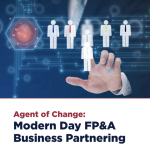In this paper, we will explore these different areas to explain what they are, how they...

Introduction
In the business game, it's not uncommon for Financial Planning & Analysis (FP&A) professionals to feel stuck on the sidelines. We often feel relegated to a scorekeeping role, effectively reporting on wins and losses rather than adding value through designing plays and coaching up the players. Our position in the organisation affords us the visibility and opportunity to add real value, yet it's not always clear how to get called into this game.
The answer is partnership.
A great Business Partnering between FP&A and the broader business isn't a mere coexistence - it's a relationship built on trust, respect, and collaboration. Mutual understanding of objectives, a shared language transcending numbers, and a commitment to elevating the organisation collectively are all marks of great partnerships.
In this article, we'll explore "The ABCs of Partnership," a comprehensive set of principles designed to shift finance from mere observers to integral players in the strategic game plan. Join us on a journey where great business partnerships between FP&A and the business are not just imagined but actively pursued and realised.
Aim to Assist
In the words of Wayne Dyer, our intention creates our reality. Partnership, at its core, intends to help someone else succeed. This idea may seem obvious, but maintaining this mantra daily requires significant cognitive effort. We are most effective when we focus inward, which becomes a challenge when our desire to impact pushes our focus outward.
For example, a well-meaning finance employee may believe they are most successful when helping the business stay on budget. This framing can evolve into dictating what the company can or can't do rather than working with the business to achieve its objectives within the existing budgetary constraints.
The key is to step back and ask yourself, "Am I being useful?" If that feels unnatural, here are a few other ideas to maintain an aim to assist the business:
- Look for friction points. Some friction will always occur, but you're looking for unnecessary tension that stems from situations which are more complicated than they should be.
- Start with "why". Business Partners tend to frame their requests as tasks rather than the desired outcomes. You can shape the former if you lean in to understand the latter.
- Challenge your assumptions. In finance, we tend to default to binary responses - simple "yes" or "no" that strip away optionality. A partner starts with "how could we" or "what would have to be true" to achieve the desired outcome.
Build Clear Boxes
A black box exists when the internal mechanisms of converting inputs into outputs are vague to anyone outside the system. They are typically described in software/hardware environments but could be anything – systems, processes, or decisions.
To increase trust, you must identify what black boxes you've created and pull back the curtain to clarify them. The goal isn't to flood people with information but rather to provide a line of sight into how their inputs convert into your output. We look forward to collaboration, which requires a base of shared knowledge.
Here are a few ways to apply clear-coating:
- No grand reveals. Classic storytelling suggests the best way to tell a story is to build up to a conclusion, a grand reveal, that rewards the audience with the coveted "aha!" moment. The reverse is true in Business Partnering. Whenever possible, we lead with the conclusion to replace that anticipation with discussion and reflection. No one should have to sit through a lengthy PowerPoint presentation to learn about the fate of their business, initiative, etc.
- Simple without over-simplifying. Finance models are complex, spanning multiple Excel tabs with many formulae that could easily be corrupted or broken. No partner should be subjected to such detail. However, at the same time, they should understand what goes in and why it comes out the way it does. Try simple, stripped-of-the-nuance templates, maintaining material accuracy to show how the process works and allow partners to play with it. The easiest way to build trust is to show you've got nothing to hide.
Close the Loop
Knowledge is power, but the true power lies in how that knowledge translates to action. Most of FP&A's time tends to be spent reporting on the score – the budget vs. actuals, the result of an experiment, etc. This is classic scorekeeping – calling wins and losses. But knowing the outcome doesn't mean you've learned from the experience. Learning requires knowing what happened, why it happened, and how to apply that knowledge to the next challenge.
In short, to elevate information to insights, we must emphasise the "so what." Here are a few examples of how to do that:
- Contextualise the score with stories. Every report is an opportunity to tell a story. It enables us to reach our audience in a way that data alone can't. When we wrap the financial outcomes in our narrative, we enable our audience to connect with the numbers beyond simple wins and losses. Consider the pattern "this is where we were, this is where we are, and this is where we're going".
- Communicate proactively and often. Imagine waiting for an elevator that doesn't give you any sense of when it will arrive. You click the "Up" button, but nothing happens. The button doesn't light up, there's no status above the doors saying where the elevator currently is, etc. The longer you wait, the more anxious you get because there's a gap between your perception and expectations. As silly of an example as it is, I think it is a good one, as it reminds us that over-communicating serves as these types of signals that the machine is running as expected. Again, Business Partnering is built on trust, a function of consistency and competency, so communicating is the best way to demonstrate both.
Default to "Yes, And"
In a world of challenges, optimism is not just a mindset; it's the fuel for innovation. Unfortunately, "optimism" is not typically associated with the FP&A team. Rather, FP&A is perceived as an innovation blocker, saying "no" to anything that wasn't originally considered in a budget created months ago.
This isn't to say that finance should say "yes" to everything. Our role is to help the organisation achieve its goals by managing trade-offs. We live in a constrained environment, so we have to thread the needle of empowering the team and avoiding budgetary overreach.
The key is to say, "Yes, And." This framework comes from comedy, where performers accept and, most importantly, build on each other's ideas instead of trying to outdo them. The intent is not to develop every idea but to maximise momentum by focusing energy on building upon each other rather than tearing each other down. Often, the words "yes, and" aren't even uttered – the new information is implicitly accepted and built upon.
How we respond is just as important as what we say. The "Yes, And" framework enables us to ensure our partners feel heard and valued, regardless of the decision.
Eliminate Ambiguity
Bias to action is a force multiplier. Finance's challenge in fostering a bias-to-action culture is balancing acknowledging uncertainties without dwelling on them. Too much confidence could lead to risky decisions, and too little leads to paralysis by analysis.
Here are some ideas on how to eliminate ambiguity to build velocity with your Business Partners:
- Start with what you know. The best way to avoid dwelling on unknowns is to lay out what is known and what's unknown. Once you can focus on the unknowns, you can often make reasonable assumptions, allowing the initiative to progress. Yes, the assumptions may be wrong, but having an expectation enables measurement, allowing the team to take action as events unfold.
- Write it down. Often, stakeholders will delay a decision because of uncertainty. Most business decisions lack the requisite data to build a fool-proof model, but we often have enough to build a range of outcomes that size the opportunity within a certain confidence level. Rather than dwelling on what is unknown, build models based on what is known and allow the range of outcomes to help guide the decision.
Conclusion
FP&A's success is intertwined with the success of our organisations. By building best-in-class partnerships within our teams, we're not just advancing our careers but shaping the future of finance. By leveraging the ABCs above, we can put ourselves in a position to be elevated from scorekeeper to strategic partner.
Subscribe to
FP&A Trends Digest

We will regularly update you on the latest trends and developments in FP&A. Take the opportunity to have articles written by finance thought leaders delivered directly to your inbox; watch compelling webinars; connect with like-minded professionals; and become a part of our global community.






